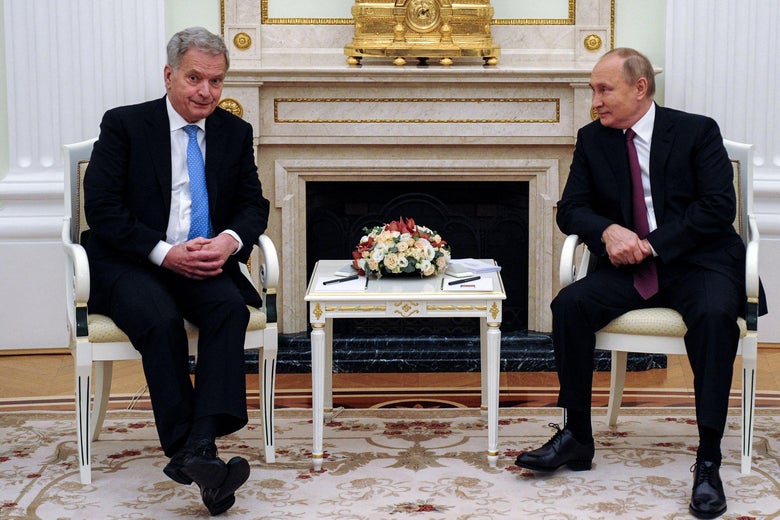FRED KAPLAN

The fact that Finland and Sweden are about to join NATO is even more remarkable than many media accounts portray. Not only have both countries maintained a studied neutrality for many decades, they—especially Finland—have done so under the thumb of pressure from Moscow.
During the Cold War, the term Finlandization was coined to describe a nominally independent country whose foreign (and, to some extent, domestic) policies were dictated by a neighboring great power.
In the 1970s, when West Germany led the way in pursuing friendly relations with the Soviet Union, some U.S. officials feared that Moscow would exploit the overtures and “Finlandize” our front-line ally in the East-West standoff. Just a few months ago, when Vladimir Putin was surrounding Ukraine with military forces, some suggested Finlandization as a way to stave off an invasion.
This is why it ranks so high in the catalog of unlikely events, in this era of unlikely events, that Finland—along with its neighbor in neutrality, Sweden—stands poised to join not just the world’s most powerful military alliance but an alliance whose main purpose is to contain Russian aggression.
Putin’s invasion of Ukraine is the impetus of this move. Applying for NATO membership wasn’t on any Finnish or Swedish politicians’ to-do list before Feb. 24 of this year; nor did the idea entice a majority of their populations, as it very much does now.
Still, the move isn’t exactly sudden. In 1995, both nations (along with Austria, the other bulwark of neutrality) joined the European Union. By that time, they had also joined the Partnership for Peace, a program devised by President Bill Clinton to help the former nations of the Soviet bloc—as well as neutral powers—integrate with the West through free markets and democratic institutions. Though PfP wasn’t a military alliance, one of its planks also helped those countries reform their armed forces—which, among other things, meant buying and training with the same weapons that NATO countries bought and used.
Ivo Daalder, President Barack Obama’s first NATO ambassador, recalls that by the time he took office, in 2009, Finland and Sweden were both “very much up to snuff” on NATO standards and practices—one of the key qualifications that applicants must pass before gaining admission into the alliance. They had deployed troops to Kosovo and Afghanistan; Sweden even supplied intelligence and surveillance to NATO’s 2011 operation in Libya.
Still, they had no inclination to join NATO. This was despite the fact that the most blatant days of Finlandization had ended with the Cold War: No Russian leader had the leverage to influence Finland’s or Sweden’s foreign policy, and both countries had gone a long way toward becoming full-fledged Westerners. However, Finland shared (and still shares) an 800-mile border with Russia; its leaders were well aware that Russian troops could cross that border with little difficulty; and they understood the benefits of keeping that border stable—of not provoking the Kremlin’s leader or making him feel surrounded.
This was no abstract matter. In November 1939, three months after the outbreak of World War II, the Soviet Union invaded Finland, mainly to keep St. Petersburg—then called Leningrad and a mere 20 miles from the Finnish border—secure. The Finns resisted for more than three months, fighting off Soviet tanks with ambush tactics (which some see as a precursor to Ukraine’s tactics today). The “Winter War,” as it was called, ended with a treaty that gave Russia 10 percent of Finland’s land in exchange for assurances of Finnish territory. This deal—which codified a mix of mutual interest, leeriness, and respect—marked the beginning of Finlandization.
For the next 80 years, Finns and Swedes were inclined to respect Russian security interests, as the Kremlin defined them, even as they joined every Western institution except for NATO—the most binding alliance—and they steered clear of that for two reasons: They knew it would ignite the Kremlin’s paranoia; and they didn’t think they needed NATO’s protection as long as relations with the Kremlin stayed calm.
Putin’s invasion of Ukraine changed all that. It revealed an inflamed paranoia in the Kremlin, and, given the realities of geography alone, it made Finns and Swedes realize they could use some protection after all—especially Article 5 of the North Atlantic Treaty, which obliges members to treat an attack on one as an attack on them all.
The inclusion of Finland and Sweden would also help NATO considerably, bolstering the defenses of Estonia, Latvia, and Lithuania—among the smallest and most vulnerable alliance members—from the north and across the Baltic Sea.
In yet one more way, then, Putin has stirred to life his most dreaded nightmares. Ever since the 1917 Revolution, Soviet (and now Russian) leaders have worried—all of them sincerely, often for good reason—about “encirclement” by their capitalist foes. The invasion of Ukraine reawakened NATO as a military alliance, stiffened its trans-Atlantic ties to the United States, and even compelled Germany to new heights in defense spending. Now with Finland and Sweden about to join as NATO’s 31st and 32nd members, Russia finds itself almost literally encircled—right up to its borders from the south, west, and north.
Regardless of how much longer Putin lasts or what sort of leader succeeds him, his tenure—two decades of a wannabe strongman nostalgic for empire—is likely to be viewed as a disaster for Russian security, the steepest setback since the shattering of the Soviet Union. Given the history between the two countries, it’s fitting that Finland is driving in the stake.
No comments:
Post a Comment